The Acer Swift 3 SF315-41 Review: Ryzen Meets Laptop
by Brett Howse on May 3, 2018 8:00 AM EST- Posted in
- Laptops
- Acer
- AMD
- Ryzen
- Ryzen Mobile
- Raven Ridge
GPU Performance: Vega at 15-Watts
We’ve been stuck in a bit of a rut with laptops lately. Intel has been offering solid CPU performance for the past several years, but their integrated graphics solution, while excellent for media playback and desktop usage, struggles under any sort of 3D load. Enter the Vega GPU in Ryzen.
Vega, if you follow GPUs, is the current generation GPU that AMD offers for the desktop, but they’ve also modularized it to be able to pack it into a 15-Watt SoC. The Ryzen 5 2500U and Ryzen 7 2700U are pretty similar on the CPU side, with only 200 MHz of frequency separating them, but on the GPU side, AMD offers 8 Radeon Vega CUs in the 2500U, and 10 Vega CUs in the 2700U. As well, the higher-level model offers a higher maximum boost frequency of 1300 MHz on the 2700U versus 1100 MHz on the 2500U.
This is full Vega as well. For a deep dive, check out the Vega launch article, but this U series SoC offers the same features as its bigger desktop cousins, such as Rapid Packed Math, the improved geometry engine, and of course, the media blocks, such as 10-bit HEVC hardware offload, and VP9 hardware as well.
The Acer Swift 3 was run through our standard laptop GPU suite, and unlike the Intel 15-Watt parts, we ran it through the full suite. We’re in the midst of introducing a 2018 laptop GPU suite, but like the CPU tests, it’s important to have more data even if the games are older.
Looking at our comparisons, we’ve got a wide range. The Surface Book 2 offers a very powerful NVIDIA GTX 1060 GPU, in the same 15-inch size as the Acer Swift 3. The Surface Pro tablet is one of the few models we’ve seen with Intel’s Iris GPU, offering double the execution units over the normal HD620 or UHD620 found in the ASUS ZenBook 3.
3DMark
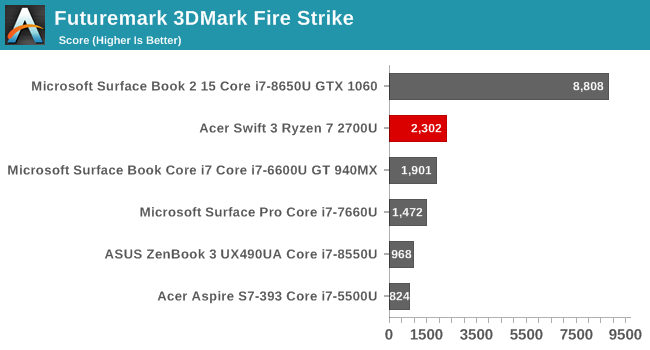
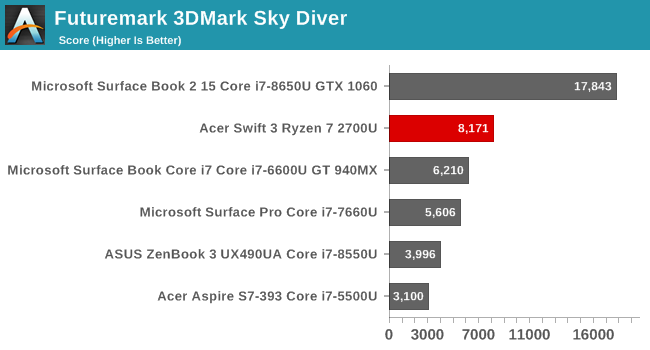
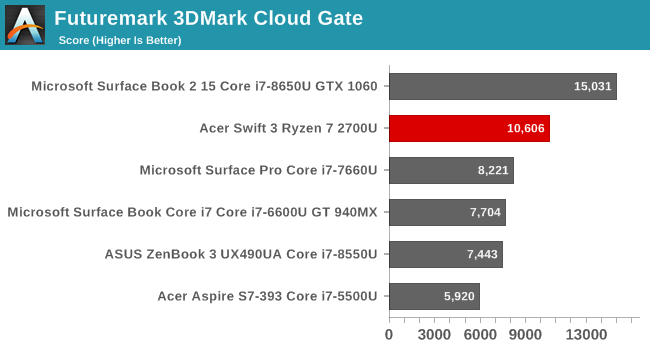

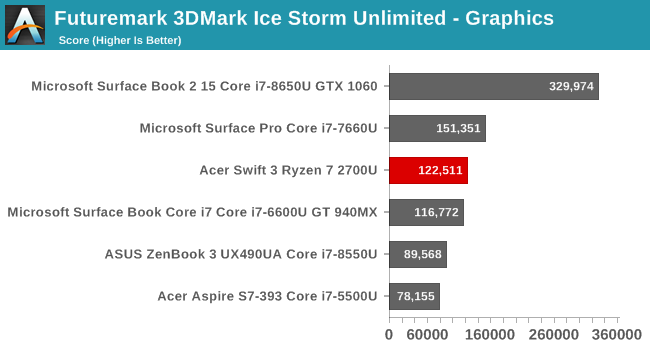
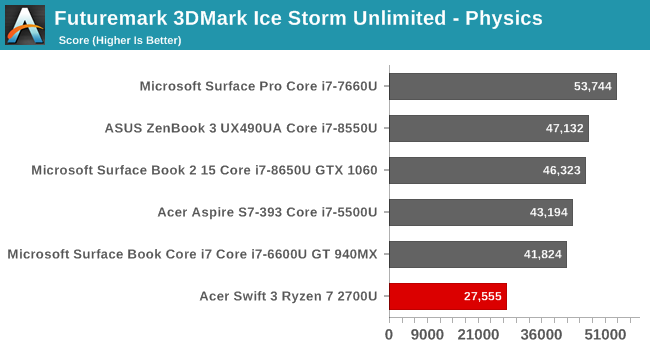
There’s a lot of interesting data to look at here. 3DMark offers several tests of increasing complexity, with the order of most demanding to least demanding being how they are presented above, with Fire Strike being the most demanding, and Ice Storm Unlimited the least.
Ryzen mops the floor with Intel’s GPU in any specification, including the Iris model. On Fire Strike, the CPU is the smaller factor, and the GPU runs away with it. As the tests get less demanding, they become more CPU bound though, and the less performant Zen cores bring down the overall results. That’s most obvious in the Ice Storm test, where we record the individual scores for GPU and CPU as well. The Physics result is a CPU bound test, and Intel’s ILP is clearly stronger.
GFXBench
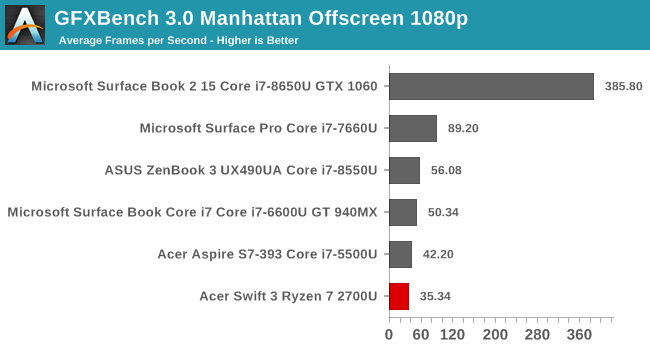
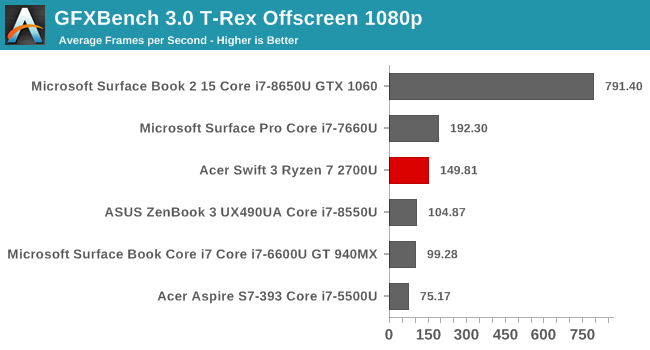
Although a benchmark geared towards smartphones and tablets, it’s always interesting to see how low-power laptops perform, even if the results are not 1:1 comparable. Here we seem to run into an issue with AMD’s OpenGL drivers, which are well behind in the Manhattan test compared to the Intel iGPU. Luckily for AMD, OpenGL isn’t a big focus right now, so despite the poor result, it’s not going to impact very many people.
Dota 2
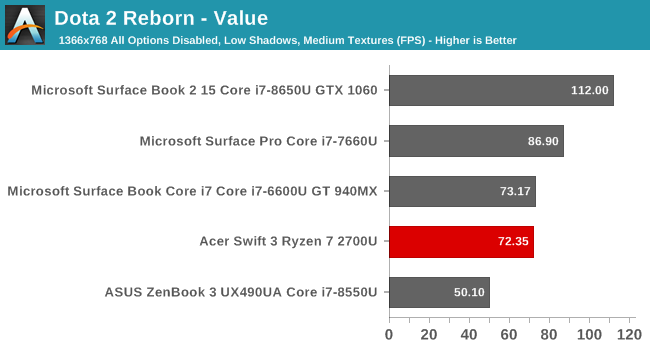
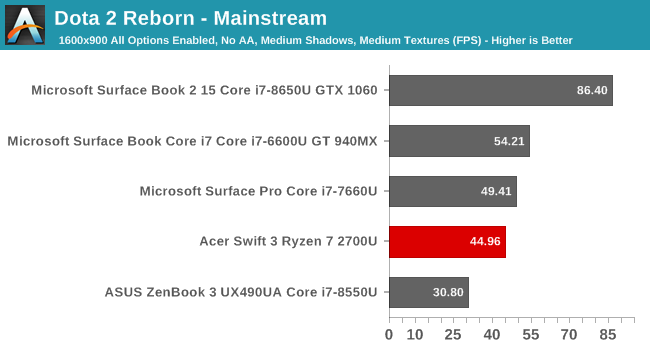
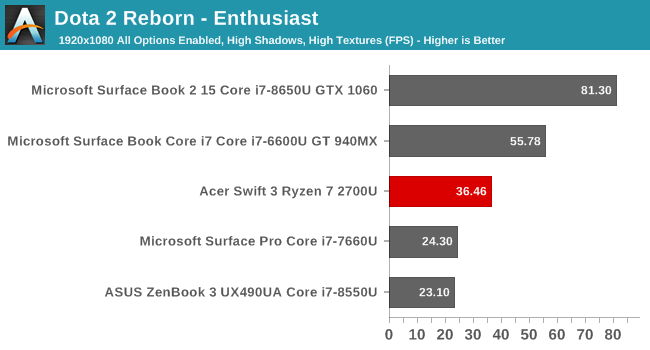
On most 15-Watt laptops, this is the only gaming benchmark we even test, because it’s one of the few that’s at least playable on low-end hardware. It’s actually CPU bound with even modest GPUs, but we can see the Ryzen 7 2700U easily surpasses the Core i7-8550U at all levels. The Surface Pro though with Intel Iris is able to stay ahead until the 1080p level thanks to the CPU performance and larger Iris GPU.
Tomb Raider
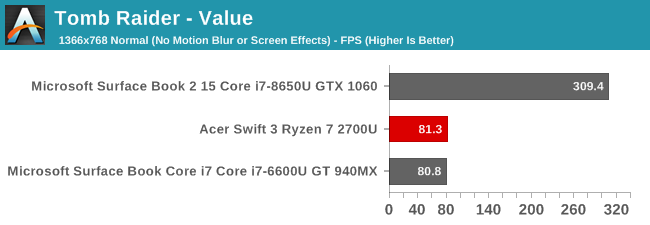
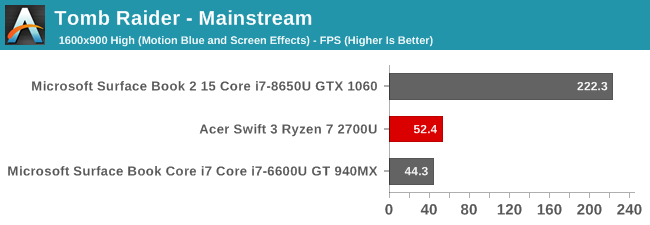
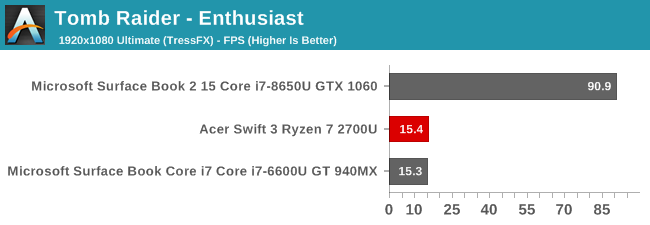
Although several years old now, the original Tomb Raider reboot is still a great looking game, and at maximum settings can be punishing to laptop GPUs. But it’s important to note that the Ryzen 7 is easily playable at low to medium settings.
Rise of the Tomb Raider

Newer, and even more demanding, Rise of the Tomb Raider is still a bit out of reach for even the Ryzen integrated GPU.
Civilization 6

Once again, Civ VI is playable on low settings, especially since it’s not a twitchy game.
Bioshock
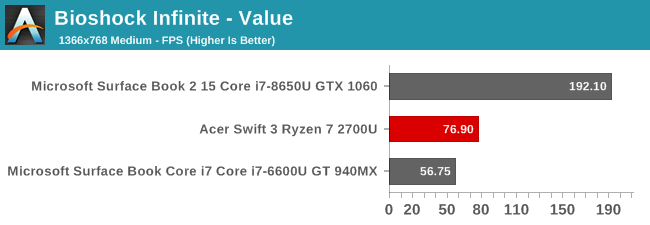
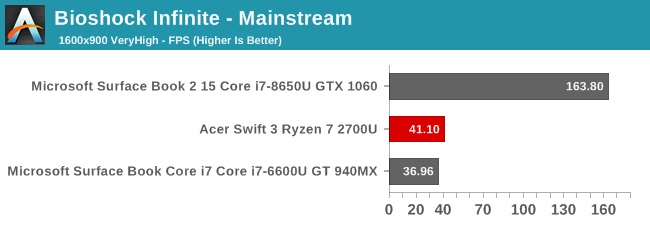
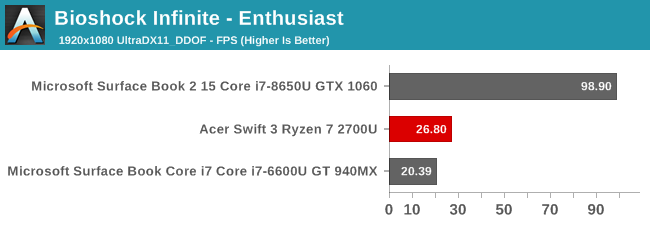
It’ll be sad to put this game to rest in our test suite since we have a tremendous amount of data for it, but it’s a good test for the kind of game you could expect to play well on a device with an integrated Vega GPU, and the Ryzen 7 performs quite well unless you max out the settings.
Shadow of Mordor

While getting close to the limits of playable, you could get by on Shadow of Mordor on lighter settings.
Grid Autosport



This game was very playable on the integrated graphics, although at maximum settings it’s kind of on the edge.
GPU Conclusion
For the longest time, we’ve been wondering if Intel’s GPU limits are due to architecture or TDP, since they’ve not really improved much over the years. Even the Iris graphics struggle. AMD has proven that theory wrong. Despite sharing just 15-Watts between the CPU and GPU, Ryzen 7 delivers respectable performance from the GPU, allowing gaming on integrated graphics with quite a bit of success. No, it can’t compete with the GTX 1060 in the Surface Book 2, but it does outperform the GT 940MX in the original Surface Book. The GPU in the Ryzen 7 2700U is just impressive.










78 Comments
View All Comments
Zan Lynx - Friday, May 4, 2018 - link
It might be something to do with power plans. Is it running default Windows Balanced, Ryzen Balanced, or some other thing? It matters.I know that in Linux using the standard cpufreq settings is a bad idea for Ryzen. It disables in-cpu speed setting and limits it to 2 GHz until the driver gets around to noticing the extra load. Just setting the CPU to its maximum allowed speed is better. The CPU can then decide to run slower when there isn't anything to do, but is instantly ready for high speed.
neblogai - Friday, May 4, 2018 - link
On the other hand- Acer Aspire with 2200U runs games better with it's CPU limited to 1600MHz- because then more power is directed towards the iGPU, it boosts higher, and provides better fps.darkich - Saturday, May 5, 2018 - link
See my comment above..the iPhone also crushes it on GPU side.tipoo - Monday, May 7, 2018 - link
"No, it can’t compete with the GTX 1060 in the Surface Book 2, but it does outperform the GT 940MX in the original Surface Book. The GPU in the Ryzen 7 2700U is just impressive."I'd like to see this pitted against the MX150 in its sibling Intel model. That also beats the 940MX by a fair bit per watt.
AnthonyJohn - Monday, May 7, 2018 - link
WOW !!!!! AmazingYou can find all movies you want if you read this blog with us
https://tophotmovies2000.blogspot.com/2017/12/10-b...
https://topanimecharacters.blogspot.com/2017/12/to...
https://blogmoviesonlines.blogspot.co.uk/
https://blogmoviesonlines.blogspot.com/
lmcd - Wednesday, May 9, 2018 - link
If you still have this laptop, please give us an overview of its Linux performance. Doesn't have to be anything super great and could just be a pipeline piece.Reason I ask: old AMD laptop CPUs stunk. Intel IGPs still stink. Nvidia graphics on Linux stinks. Graphics switching with discrete AMD on Intel stinks. Net result: this might be the best option. Even if you just ran an old bench like Unigine Heaven and did web browser rundown tests or something like that, I would be extremely grateful.
ballsystemlord - Wednesday, May 23, 2018 - link
I am in agreement with Imcd. Linux gets lost when it comes to the laptop.I must point out Imcd, that xonotic and openarena would be better benchmarks by far for linux than Unigine Heaven as they are native programs not requiring the luser to purchase them and are both highly optimized.
As for Linux CPU benchmarks, a linux kernel compile would be standard. A web one would be firefox or webkit based. A pdf render could be done with gv. A few imagemagick benchmarks can use openmp and opencl. Blender is also a native program and can render on both CPU and GPU. You could transcode video with ffmpeg. Audio with the included tool (flac, oggenc, etc.), would also be good.
Jimster480 - Monday, May 28, 2018 - link
Personally.... this laptop is actually HORRIBLE for the price.Another work of Intel's anticompetitive hand in the jar.
Ryzen parts are cheaper than Intel parts.... but for some reason they have to make the laptop with bottom-tier specs and a top-tier price... FOr this price I can buy a full 15.6 i7 HQ laptop with a dedicated GPU and a nice IPS screen and M.2 or NVMe drive...
Instead I get a forced 8GB soldered 2133 (probably single channel) memory to gimp Ryzen as much as possible... and atrocious screen and a subpar battery.
Just so that NOBODY will actually purchase this. ANd this type of gimped trash configuration is the same across all brands.
Every company is making the same overpriced garbage, meaning that nobody will buy Ryzen laptops just due to the outragous uncompetitive pricing and performance.
None of these MFG's have a justification for these prices... and every OEM that has announced any good Ryzen laptop.... well it hasn't ever shown up. Just like Acers own Nitro 5 Ryzen laptop (looking to be the first good Ryzen laptop that will launch) and they just pulled the plug on it some days ago after being 40 days late with launching it...